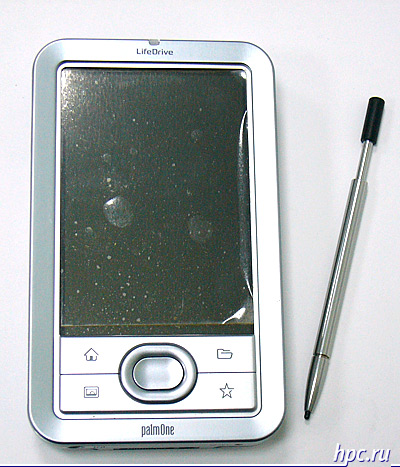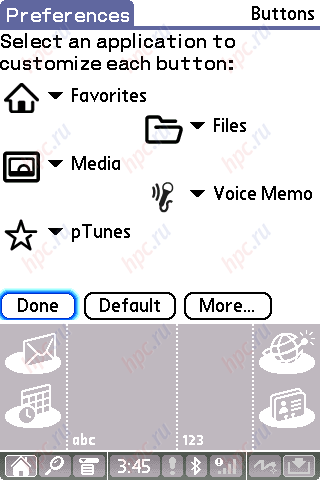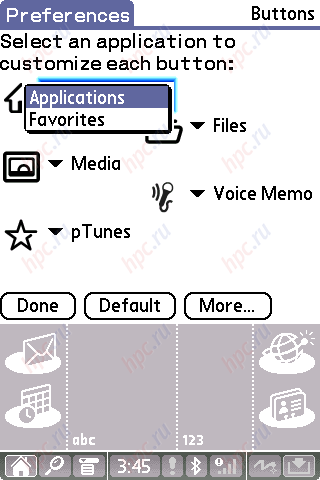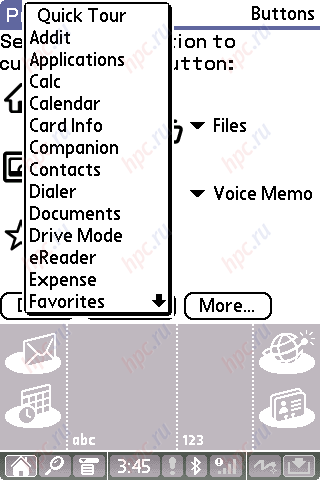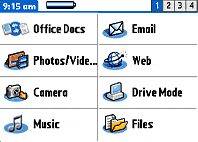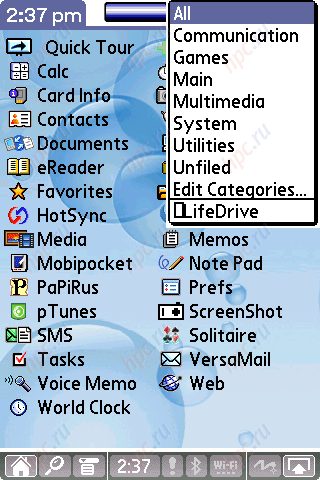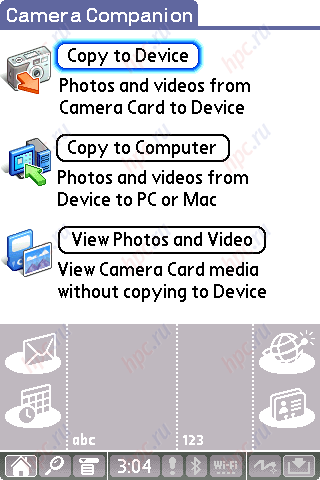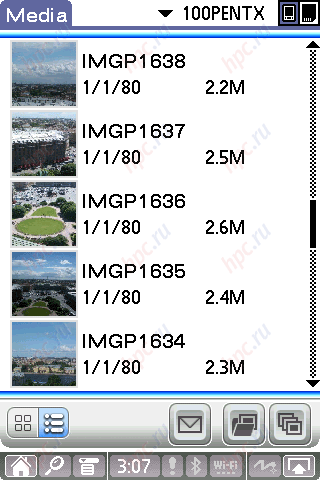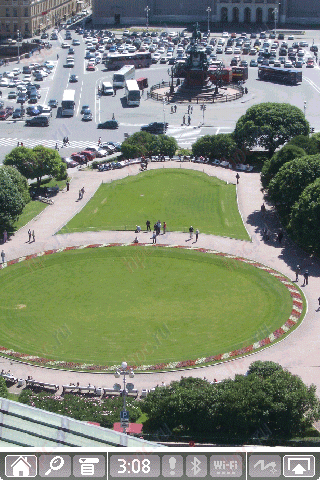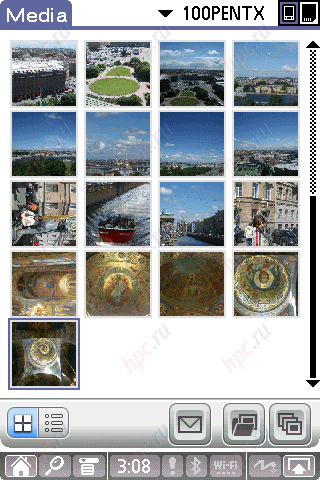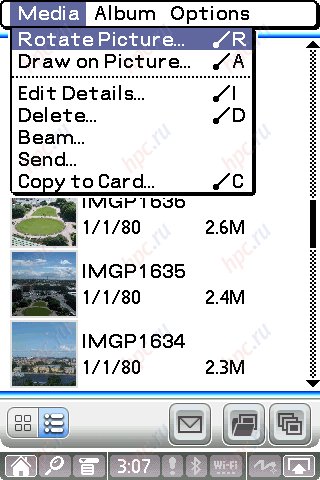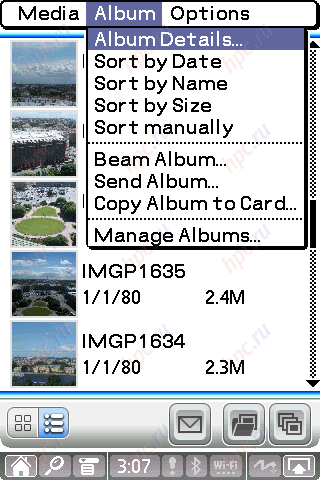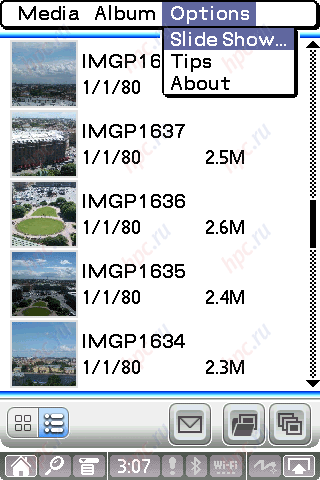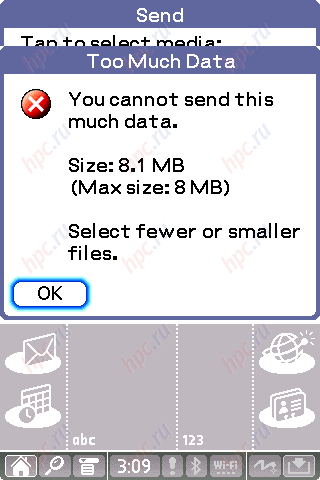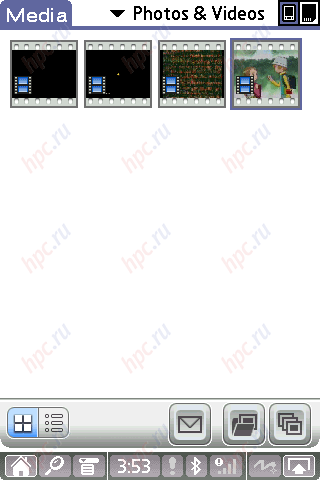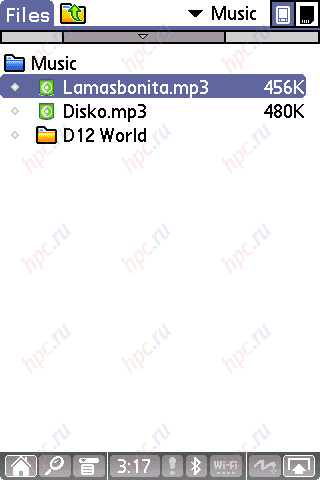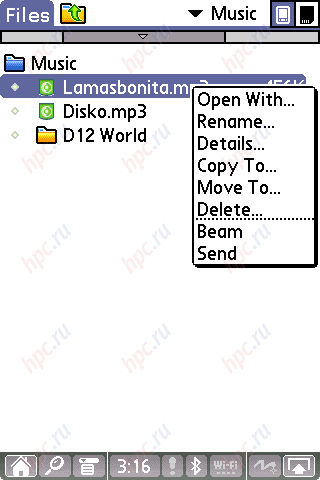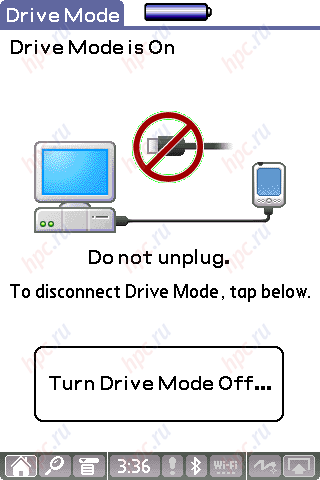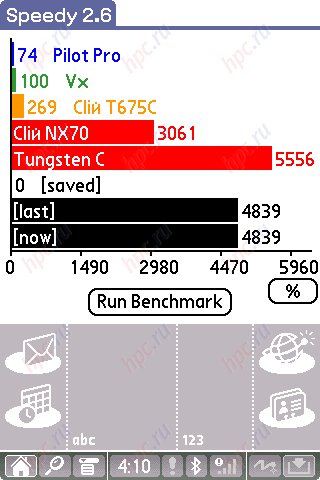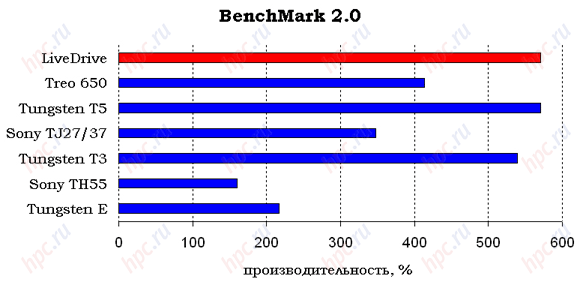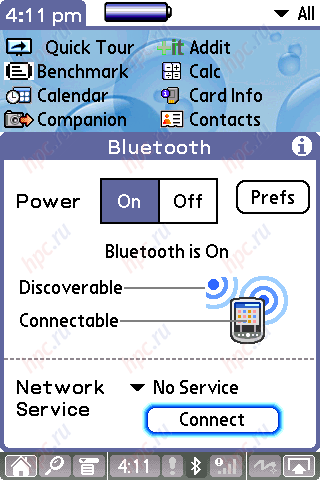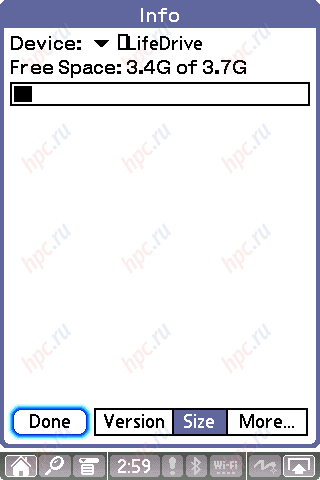If we're talking about competition in the field of computer, it always reminded of the PC and Macintosh. Confronting these two platforms in the second half of last century, has actively promoted the progress of computer technology. Struggling with a PC, Apple constantly releases new products, emphasizing on the design ideas combined with the functionality and convenience. "Apple" company owns many well-known and once very popular products. One of the last to have won the hearts of many millions of users (especially in the U.S.) - iPod digital music player with built-in hard drive. Its success spawned many followers. And it is natural because both want to repeat someone else's success story. Production PDAs Apple, unfortunately, is not going to do. It in this segment successfully replaces the company palmOne, which is virtually alone (after the departure of Sony) is opposed to the storm and onslaught camp Pocket PC. So that developers from palmOne "have adopted a" one of the ideas of older brothers and the world have revealed a new concept of a handheld computer LifeDrive Mobile Manager with built-in hard drive. However, as shown neutihayuschie controversy that began virtually from the day of presentation of this model, "this tree has fallen too far from the tree." Instead of the march, which marched on the planet since the introduction of a prototype of our hero, iPod, a new LifeDrive "shifting from foot to foot, waiting for the verdict of the Internet community. I must say that in the early days of too much negativity spilled on to the heads of developers LD, so that now, after nearly two months, it's time to calm down and discuss "all the decorum and dignified, as in former times." Especially that machine to get to our editorial staff. In short, let us begin. However, before moving to specifics, we make a small digression.
Where does a barrel of tar?
Before there as to initiate the testing, we tried to understand the brief history of the LifeDrive, replete with negative reviews, the first testers (see our first review on the topic "LifeDrive Mobile Manager: drive in rush ?.."). Why a new product did not show leniency in view of its uniqueness? Why this CCP caused such controversy and such a wave of negativity from many users? .. The thing is the novelty device as such - and as a consequence, in an unusual PDA users of the product. More specifically, in the not too clear at first glance, the organization of memory, hard disk drive and a very controversial implementation Hard Reset'a. Furthermore, LD has not one adds an attractive feature - its main advantages turned into a number of disadvantages, as well as a good idea not fully thought out the embodiment. In this article we will try to answer the questions - how everything is arranged inside the LifeDrive PDA, and why this is such controversial impressions. To avoid accusations of bias in the mind of the author and apparent ambiguity of the model, we offer the opinion of the CCP from the two users. The first - our regular writer, who sympathizes with the Pocket PC and the second - a longtime fan of the platform Palm, and, respectively, and all that produces palmOne, "palmklubovets Yuri Sokolov, eagerly waited out LD. The main text belongs to our author, and add to it, highlighted in green font - Yuri. Looking ahead, we say that the tester both practically concurred in largely complementary. However, first things first.
Sketch
We list the specifications LifeDrive, which can serve only to "sketch" of his portrait: - Operating system: Palm OS Garnet 5.4.8
- Processor: Intel XScale PXA270 416 MHz
- Hard Disk: 4.0 GB (3.85 GB available)
- Memory: 16 MB ROM and 32 MB of nonvolatile RAM (NVRAM); 64 MB "program memory" on your hard drive
- Screen: 3.8 "(96 mm) transflective TFT, 320x480 pixels, 65,536 colors
- Memory Expansion: MMC / SD / SDIO
- Communication: IrDA, Bluetooth, Wi-Fi, USB
- Entering Data: Graffiti 2 v.5.2 (Jot 1.3.P1), virtual onscreen keyboard
- Battery: Li-ion, non-removable, 1660 mAh, 3.7V
- Audio: microphone, speaker, 3.5-mm headphone jack
- Dimensions and weight: 121 x 73 x 19 mm and 190 g
Since we are dealing with a unique device, the LifeDrive and correct to compare with any PDA is difficult. But for clarity, we do offer you to evaluate the new product against its predecessor Tungsten T5 and rival of Pocket PC-camp, HP iPAQ hx4700, such as hi-end handhelds from major competitor palmOne - the company HP. You can do this, use the "Compare devices" in the "Catalogue of the CPC on HPCru.
 |
| palmOne Tungsten T5, LifeDrive and HP iPAQ hx4700 |
As can be seen, the length and width iPAQ even exceed our hero. The reason - a screen of 640x480 pixels plus 4 vs 480x320 c diagonal of 3.8 "with LD.
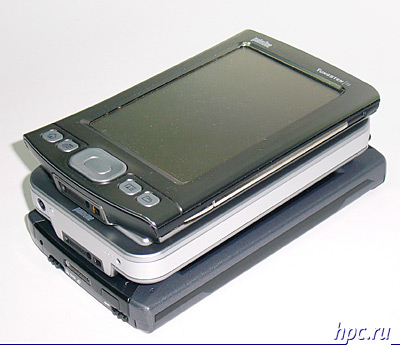 |
| Cverhu down: Tungsten T5, LifeDrive and iPAQ hx4700 |
But the thickness at the palm trees on four critical millimeters more than the HP. C Tungsten T5 and the comparison is not worth it. These PDA - obviously in different "weight" categories. The only thing that suggests a relationship - almost identical to the filling. At T5 is worth to the same processor, screen, expansion slot, built-in Bluetooth 1.1. The hardware differences are in the presence of another wireless controller, Wi-Fi (802.11b), HDD from Hitachi and as a consequence of an organization's memory, as well as extended battery 1660 mAh. At the program level, all a bit complicated, but more on that below.
KompLektatsiya
Inside the box you can find: - the device itself
- stylus
- Adapter
- sync cable
- cover
- 2 CD with software
- a large number of pamphlets
- Quick start guide (full disk as a PDF file)
"Synchronization cable and charger, exactly the same as that of TT5 and Treo 650. By the way, a set of LD - clear indicator how bad waive the budget PDA cradle, the epidemic here also apply to the entire model range. Obviously, palmOne decided that so if the buyer posted five hundred dollars for a high-end device, you really do not sin with him still in the cradle to take. "By the way, the original accessories, which are offered for palmOne LD, can be found here. Ranked Among the items: a metal cover, a folding keyboard Universal Wireless Keyboard, cradle, SD Memory Card 1 GB and all kinds of cables with a stylus.
DIzayn
First impression - shocking. Immediately pose the question: "Is not it slipped my Pocket PC instead of the promised Palm
OS"? "Typewriter original - you understand that once, when to get it from a box. Then, by the way, it becomes clear why she gently called" Mobile Manager ". Calling this PDA (handheld computer), I would not dare.Tungsten T5 in size to its background - just a magazine cover.
The design is very controversial in the photographs looked very even nothing, but in reality - what is he HUGE! In the men's hand LD is still ok, but in the women's arm ... "  |
It's hard not to agree, in fact, very large specimens. However, it is worth remembering built-in hard drive, and all at once falls into place. What did you expect? Somewhere as it should be put. Argue the same about the design of the device, the more thankless task. Some like that LifeDrive has strict outlines, tuning on the business mood. Others criticized the contrary is so straightforward style, calling novelty brick. One impressed partially metal body, while others believe that plastic is not worse, and at the same time cheaper and easier. How many people, so many opinions. Let us leave the matter to your discretion. In my view, the external device looks very stylish and colidno, but keep it in your hands is not very convenient because of serious dimensions, despite the fact that the back of the specially rounded, podctat palm.
"Joystick and buttons - no complaints, well-practiced and comfortable, despite the unusual form. But he and the buttons - do not miss it. At the lower end devices are located: a connector sync / charge, a standard 3.5 "headphone jack, and reset-hole. On the left side are a microphone, a voice recorder button and a button to rotate the screen 90 degrees (portrait / landscape display modes). Five of the six hardware buttons to devices - flash (four on the front panel and a voice recorder button).
However, on the upper left button can be "planted" only two applications - Applications and Favorites.
But for the remaining choice - is huge.
Unconventionally for palmOne made the power button. This is a well-known two-position slide lever, appeared on the PDA from Sony. Potyanesh in one direction - the unit is turned potyanesh to another - will lock hardware buttons (HOLD).
"We should immediately note that a switch in my opinion, made a very unfortunate and uncomfortable. I'm not the first time turned off machine with Hold'a, and it does not turn it off." As for convenience, the switch can be argued. The whole point is, excuse me, in the amount of fingers and long nails. To me, nothing difficult in the switching of the lever is not, although the Hold button on the Dell X50v much cpodruchnee. We continue the examination. Also at the top end there was a place for the expansion slot SD / MMC / SDIO, infrared port (left of the switch), a silo with an original mechanism of issuance of contents (click on the pen tip - and it is served up) and LED indicator. palmOne, finally, is equipped with a PDA the signaling. True, is entrusted with two tasks: support for charging LD and the hard disk. At the junction of the upper end and a front panel LED indicator rasplozhilsya. It is gratifying that palmOne, finally, is equipped with a PDA the signaling. True, the last assigned whitelist several objectives: support the charging LD (orange and green during the end), the hard drive (blinking orange), Wi-Fi work and alarm reminders, if the CCP muted.
"Indicator, derived on the front cover, works quite muddled. The charging process is shown and the ending - no. Even the process of charging it showed that orange and green, and, on the level of charge is not dependent. When the machine is occupied by something else, the charge indicator is turned off in general, PDA and begins to show something different. "Tellingly, in my testing process with a charge indicator everything was normal. Noticed only one peculiarity: LED indicates a full charge, unplug the power cord, and after several minutes of level "falls to 80% - the true level of charge. The general rule is for all the LifeDrive or glitch particular device, difficult to say. But in order to "fill a full tank, the battery must be given an additional 30-60 minutes. The back of the LifeDrive is designed as a large grid of cooling. It is understandable - after all your hard drive. I must admit that in the process of reading books or manipulation of PIM applications (when the PDA is directly in the hands) is heated it is not so much, but when playing MP3 - significantly. Hands, of course, does not burn, but keep it in this case is better in your pocket.
SoFt
The software of the new LD, according to the marketing plan, bears a proud name - LifeDrive smartfile management. That invites us to palmOne, to quickly and effectively to control the amount of data, which allows you to store the CCP to instantly share files between desktop and pocket PC? First, LifeDrive Manager - handy file manager for the desktop, which allows you to work c hard drive PDA as usual c external hard drive.
Secondly, Drive Mode - program that allows to switch the CPC mode USB-drive, that is, to communicate with other PCs without installing additional software, desktop parts. Thirdly, Files - a simple file manager. In general, this is quite sufficient set for inventory control LD, but more about what these programs will be discussed below. Also, for the core mission of LD at the disposal has everything you need to play photo-video audio (this is again below).In addition,
by default in a standard typewriter "palmovsky" a set of PIM applications. From New: built-in toy Solitaire "Klondike" (finally thought that the mobile manager needs something to occupy myself on the way), rather a strange program called Camera Companion. In my opinion, it's just a step by step Wizard to copy files from card to HDD devaysa. As a player, the audio files used PocketTunes 3.0.9. To work with the Internet browser predusmotrery Web (former Blazer) and the mailer VersaMail. To work with office documents used Documents To Go, version 7005, so you need to immediately download a recent version. Recall that the main advantage of Documents to Go is the ability to work with documents "native" format Microsoft. Quality of work - at a decent level. With small documents is no problem. Large same documents (with pictures inside) or PowerPoint presentation can be a very long time (5-10 seconds) closed or opened. In addition, a general lack of - first run, which takes some time until the disk spins up and copies the program into the cache. Here is a list of all installed software.
Group "Basic Application": - Applications
- Quick Tour
- Calculator
- Contacts
- Phone Dialer
- Documents to Go
- Drive Mode
- Expense
- Favorites
- Files v. 2.0
- Memos
- Note Pad
- SMS
- Tasks
- Versa Mail v. 3.1
- Voice Memo
- Web (Blazer v. 4.1)
- Word Clock
- Graffiti 2 v. 5.2P
Group "Multimedia": - Media v. 3.0.0.23
- Camera Companion v. 1.0
- Pocket Tunes v. 3.0.9.
The group "System Applications": - Card Info
- Preferences
- HotSync
- Security
- Bluetooth
- WiFileT
- Drive Mode
Games: - Solitaire by Handmark
Additional software: - Addit! v.3.76
- Palm eReader
- Adobe Reader
PC-side: - LifeDrive Manager
- Adobe Reader
- Audible Player (only reference)
- Microsoft Outlook conduits
- Real Rhapsody 3.0 Desktop
- Windows Media Player / DirectX
Let us dwell on some of these programs.
Camera Companion
This is a program for managing files on a memory card of your digital camera. In LD can insert the SD from the "numbers" and using the above program to download photos to your hard drive LifeDrive. Thus, kill at once two hares: you loose the card, securely store data on your hard drive and view photos on a relatively large (compared to the camera display) screen PDA.
You can also copy photos to your hard drive desktop computer (but will need to switch the CCP regime Drive Mode). The words, the program is quite strange (since all the same thing can be done with the built-in file manager), but very comfortable.
Media
This application is designed for viewing digital images (photographs, drawings, etc.) and video files.
Media can: - sort of media files
- send them (or the whole album) by mail (when connecting to the network), SMS (in conjunction with the phone) or Bluetooth
- rotate the image
- make a sketch or an inscription from the hand directly above the photo
Minimum, but for most users ample feature set. Please note that the file transfer there is a limit - maximum size of 8MB.
The program can also play video files MPEG-1, without prior conversion. Files to MPEG-2 already has pre-converted to the format, "digestible" for the computer (ASF). Fortunately, the procedure for conversion is done automatically, similar to Microsoft ActiveSync. When you transfer the file, the program asks what type of backup to use and by the user, or move it without changes, or convert to a format understood by the player.
To convert was possible on a desktop computer must be installed with the software firm CD. Unfortunately, it was not possible to convert files to DivX and XviD, but most likely, due to lack of codecs. In principle, to convert this format to be able LifeDrive. The only drawback of the program is the lack of repetition functions play the file. During testing we had to use the hours movies:)
Files
Ordinary file manager. But frankly, this is for Pocket PC such program - the thing everyday, and for the Palm OS File Manager "became his" relatively recently.
As well as on Pocket PC, by pressing the stylus on the file, a list of what you can do with it (forward, copy, rename, assign the program to run the application).
There is only one drawback - the file manager can only work with hard drives and external memory card. For built-in memory, such luxury is not available. One gets the impression that there is a clear delineation of the program interface: internal memory - it's the same good old Palm OS, and external memory - it is almost Windows. The fact that the external memory (HDD, SD) have programs with an almost "of windows and is very familiar desktop interface, and for internal palmovskoy memory with this interface is not, and does not seem to be.
Drive Mode
When you switch to this mode, the hard drive and an external memory card is determined on a desktop computer as an additional logical drives.
In fact your handheld turns into two external USB drive. Therefore, not surprisingly, that if you disable LD from the desktop program recommends that you conduct a procedure called Safety Remove Hardware.
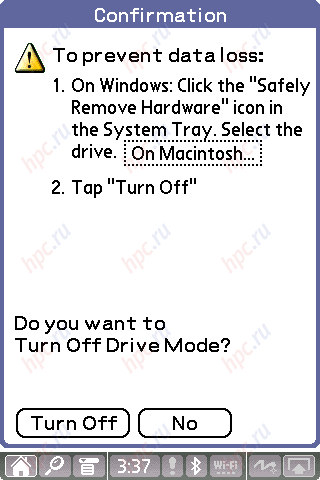 |
Some of you may ask: "Why is the regime Drive Mode, if you complete a program LifeDrive Manager desktop PC? LiveDrive Manager really makes life easier for the user. This is an optional file manager with a very accessible interface that allows you to work with the hard drive PDA, like a normal external hard drive. To transfer data there is no need to carry out the procedure for HotSync. Working with files is carried out as in the usual file manager for Windows. But unlike DriveMode the latter has its disadvantages - LD Manager must first be put on the PC. The word, this utility is good only if the costs on to your computer, you use often and you can set various software. In general, the regime DriveMode designed for easy transfer of data between computers without additional drivers or programs (at least for Windows XP and Mac OS X). In this mode, the handheld turns into a regular USB drive.
TIME battery life
How many can hold a new PDA with a hard drive? For testing, we chose the typical usage patterns. Hours measured before the first warning about battery power (from 5 to 10% capacity). Recall that the capacity installed in the LD non-removable battery is 1660 mAh. It would seem quite an impressive amount, especially for the Palm, but unfortunately, all the needs of LD it does not cover. The more a pity that the design does not allow the battery to replace it with a reserve that provides almost all Pocket PC. In the read mode with automatic scrolling text (the scrolling speed was 25-28 characters per second), our hero was held for six hours at a minimum illumination. Text file at the same time is inside the computer memory and hard disk like as not used.
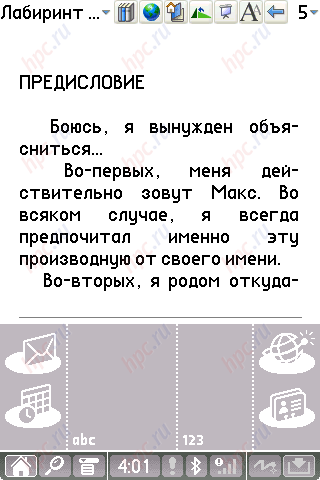 |
To put it bluntly, the result was not impressed. Runtimes for Pocket PC or a Sony PC with a VGA screen is noticeably larger. The case is likely that a LifeDrive very high level of minimum illumination. Brightness is not really such unnecessary and even harmful when reading in the dark. Now on playing MP3. As the test files used in MP3 files with the flow of 320 Kbps (display off). When playing the card of one battery charge sufficient for 10 hours, whereas when playing from the hard disk was then reduced to 7 hours. The result, of course, far from the leadership, but too bad. Video playback was tested in two modes: program Kinoma Player with internal memory of the computer program and Media (MPEG1 file with the flow of 700Kbit / c) from the hard drive. In the first case, the battery life ranges from 3 hours 50 minutes (maximum backlight) to 5 hours and 45 minutes (minimum light), in the second - from 2.5 to 4 hours. Work with the included Wi-Fi signal (continuous connection to the network and uploads) and a minimum illumination level has yielded results in 2 hours. It is quite normal. Movie download did not, but enough for two decent size (100 MB) of music albums and even read the news on Gazeta.ru. While a simple news reader (no additional downloads of large files), while the increases of up to three hours.
"So, just want to clarify that all tests were conducted at minimum brightness, with a hard disk, not the memory card. The first call from a full charge to Critical screaming machines took only four hours. It's four o'clock active Hughes, installing programs, and their work. Then the battery a little shake and indicators have improved, although there were "shedevrovymi." Generally, in standard mode (just a little), the user is guaranteed by approximately seven hours of operation. Listening to MP3 with repayment screen - about 11 hours, the video is worse - about three hours and that's that. It is bad that, as in the case of TT3 and TT5 battery indicator is not linear, that is, showing a disproportionate level of charge. In short, the machine lasts longer than the Tungsten T3 (which is already happy), but indicators TT5, and especially the Treo 650 (3 hours of video, and battery of the village less than a quarter) does not hold. Wi-Fi on the LD, really, really hungry. And the battery lasts long. However, persistence of the battery depends on the activity of the card Wi-Fi. If it is just browsing and reading the site, the Wi-Fi card has time to fall asleep than the operating time. And it is another matter, downloading files, when Wi-Fi card operates continuously, than quickly puts the battery. Still LD is not designed for downloading large amounts of a Wi-Fi, which is a pity! " A relatively small battery life for two reasons: - high minimum illumination
- the need to spin up the hard drive.
Displey
I hasten to please and disappoint some users at the same time, display the new LifeDrive by brightness and contrast performance differs little from the screen of its predecessor, Tungsten T5. The maximum brightness is 180 cd/m2. Subjective - very bright, the maximum brightness of the display T3 was more than 2 times lower - 77Kd/m2. Minimum level of brightness - 60Kd/m2, that is, one third of the maximum. Subjective - is still very bright. Especially in the dark. Contrast - an impressive 1:60 (in darkness), which is more than enough for comfortable perception of information from the display in almost any lighting conditions. The exception is, as always, work in the sun. On the street with LD, of course, you can work (even in direct sunlight), but really it does not work, and mockery of his own vision. Solving the problem is - or put to maximum brightness (contrast with the increase to 1:5), or by turning the PDA, to search for the optimal angle of reflection.
"Shield of LD, in my opinion, is the same as on TT5. The sun can not see anything .Minimum brightness regular means - very high, we could do twice as less. "
PRoizvoditelnost and memory
One of the pressing issues of today: "And how LD performance?" Reply somewhat disappointed, although we had some suspicion, even before the product has been on testing. To begin with the results of synthetic tests. These are, in my opinion, do not have much sense, but there are users for which the "interest" and "scores" - the most important arguments.
Speedy 2.6 - 4839 points (compared to Tungsten C - 5556 points, and the Palm Vx - 100 points). It turns out that the performance of the new LiveDrive Mobile Manager about the level Tungsten T5. But the results of BenchMark 2.0.
With video playback is still fun.
Video LifeDrive «pulls" 10-20% better than the Tungsten T5. Testing was conducted using Kinoma Player 1.5.1. But let us leave the synthetic tests and proceed to the subjective evaluation. The actual speed of PIM applications, a decent up until loading is coming from internal memory or external cards. Once LD is drawn to the hard drive, performance decreases significantly. Basically this happens when the hard drive is not promoted. This is especially noticeable when switching between applications. Download the program switching may occur immediately (hard drive promoted), and can take 2-3 seconds, and (you have worked too long in one application, and the hard drive "sleep":)
"Application, in my opinion, too, does not possess the speed . playback of audio and most video runs without any "brakes", even with the influx of video (more than 1 Mbps). In general, the hard drive - satisfactory. The average time to copy data is 0,9-1,3 Mb / s (depending on the size and number of files), the read speed - about 1,8-2,0 MB / sec.
"Tested copying files from card to internal HDD. Speed up - 900 kb / c ". Because when the computer is almost always appeal to the hard disk, the process of inclusion can sometimes take up to several
seconds." Shutting down the device: time can vary from 1 to 5 seconds. Moreover, because do not very convenient switch does not immediately realize you turned it or not. "conclusion - is this: as soon as the work involves contact with a hard disk, all processes are slowed down
dramatically." When you turn catches the eye set the LED on the front - still would not throw, He also shows the activity of HDD.'s nice to look at the boot - HDD works ... the only way (if Windows XP is loaded). According to him, HDD running virtually any application. "Is this true? Is zheskom drive works when you run all the applications, which seriously affects the speed PDA? Let's try to sort out their internal management, LD, memory organization and find the cause of dissatisfaction with the first testers of the unit. The fact that the LifeDrive contains a variety of memory types, and list them all problematic, but we will try. Thus, the LifeDrive includes: 16 MB ROM, 32MB RAM, nonvolatile memory, hard drive, Hitachi's 4GB.In addition, the PDA has 64 MB and the "Program Memory", which is not a memory in the usual sense, as it is located in the very fast access to your hard drive. In previous models, Palm application stored in RAM. One of the main differences LifeDrive is that for storage applications, it uses a "virtual" or program area (not RAM). As the "Program Memory" is allocated 64MB of hard disk in sectors with the fastest access. When referring to this area of the operating system it is perceived as the last 64MB of RAM, but it is not. Thus, when the application is installed on the LifeDrive using the standard procedure for HotSync, it is actually copied to your hard drive. Of course, reading, writing, and any other operations with RAM is much faster than a hard drive. Thus, the memory configuration LifeDrive can potentially cause problems and delays. Yet LifeDrive does not rely only on the hard drive to run applications. Generally speaking, the most important part of the memory architecture is not the LifeDrive hard drive. This is part of the cache memory. Cache memory is 32MB real, "honest" random access memory (RAM). Unlike previous models, Palm, the user does not have access to the RAM directly. This memory is used by the operating system as a fast cache memory. In general, such an organization of memory and data storage used in computers for quite some time and is called "virtual memory" (Virtual Memory). Using virtual memory can be both useful and harmful. When used properly, virtual memory greatly enhances the user experience, and if improperly can cause serious delays. In LifeDrive virtual memory is organized so that each time an application or data access is not from the ROM, they are copied to the hard disk cache. Application or data is stored in the cache as long as there is free space. When free space in the cache memory ends, the application will not be used for the longest time is removed and replaced with new ones. Of course, the hard disk application is still there, but next time you run it again will have to copy from disk to cache. Thus, the first load application may cause a slight delay, depending on application size - 1-2 seconds. But after the application is copied into the cache, it starts almost immediately. And if the application is running all the time, it will remain in the cache as long as the PDA is turned off. The fact is that when the device cache is reset, while the developers claim that it is similar to non-volatile memory in the TT5. This memory does not consume energy when switched off PDA, so it is not clear why it reset when turned off. In any case, palmOne should as quickly as possible to solve this problem. And finally, the last component of the memory LifeDrive - 16 MB ROM. This memory is read-only, it holds itself Palm OS and some system applications (eg, PIM). However, we should not deceive ourselves. Data that use these applications, it is still hranyatcya on your hard drive, so they must be loaded into the cache handling. After you synchronize your desktop Outlook with the LifeDrive, all data are loaded in two seconds, after which the movement of dates in the Calendar on the PDA is very fast. In addition, delays caused some regular application. Basically it refers to two programs that came with each device LifeDrive, - Media and DocsToGo. The first of these applications - viewer, Media, of which we are told in the "Soft". This new application from palmOne, and it has a few unpleasant moments. The first occurs when the PDA is written very large number of pictures or videos. In this case, the Media can be downloaded in seconds. It is interesting that in any desktop operating system, when viewing the image files to their reduced images, we have the same effect, and no one finds this surprising. PalmOne whether to pay attention to it? Maybe. But is this a reason for not LifeDrive? Of course not. For Palm OS, there are many media players and some of them, for example, TCPMP (better known as Betaplayer), free of charge.Another application, which may cause a delay at startup is Documents to Go. After downloading a large Power Point presentation to close the application takes a few seconds. Coming soon all, it has no relation to the hard drive, more to the core document conversion on the fly "Documents to Go. Let's try to draw a conclusion from the foregoing. Despite the fact that the mechanism of memory for LD could be called queer, yet the latency of the PDA - a point which is quite possible to survive and forgive a novelty in mind the presence of a hard disk, extremely passable performance of their duties cvoih and very good performance. LifeDrive today - the most powerful device based on Palm OS, not to mention its uniqueness.
Audio
In terms of sound quality LifeDrive fully justifies its multimedia function. Audio - at a decent level, even through the speaker, who, incidentally, very loud, almost as a Tungsten E. But his position on the rear panel, I would call traditionally unsuccessful. When the device is on the table (usually up display), then the volume decreases significantly. Save it stereo, but for some reason do not complete. Recall that the LifeDrive, as expected, a built-in voice recorder, the start button which is located on the left side of the device. Microphone is our hero, placed just above the keys, also has good sensitivity (you can record sound at a distance of 2-3 meters), but it is significantly limited due to its failure position. But the microphone still be reasonably placed on the top or the front panel as well, during the conversation, it is better to keep the PDA in their hands, the left end face up to the microphone was higher.
WI-Fi
"This option, which is made in my opinion is great! And without irony. The tests were in the cafe" pie ", which is near my work on the Big Dmitrovka. There also is a hot-spot, and coffee is very good, so you can combine a pleasant and the useful. Click on Wi-Fi icon in Toolbar'e and instantly get a list of all available networks to connect to the receiver signal level indication. Click on Network TasCom - and a few seconds already on the Internet. When you set up Wi-Fi is offered to choose time-out presence in the network, so that you can set a countdown, that is the time after which the system will "fall off" from the hotspot. Soon the connection is at least as bad, I max - 1 Mb in 35 seconds, and Basically the video 29 MB download for 20 minutes. "nothing to add. Is that about the quality of the signal. Transmitter at LD - very decent, within the apartment (60 sq m concrete walls) signal sensitivity does not fall below 90%. However, where the signal was lost, been found in the Marriott Hotel - one of the first public place equipped with an access point. At the same laptop in the same places at the very least, but the signal is stretched.
Bluetooth
Standard palmovsky Bluetooth manager, no different from the version for TT5. Works like a Swiss watch. Headset (Jabra BT200) and phone (Sony Ericsson T630) learns normal.
Hard driVe
Now, the most curious in the LifeDrive - built-in 4GB hard drive. Actually, not just about mikrodrayve, and the concept of "PDA + hard disk.
There really taken a lot of successful Apple iPod.LifeDrive, thanks to the hard drive and special software (pTunes, better known as Pocket Tunes, Media, Files), a mobile digital device that can be used for playing music, watching movies and photos. Moreover, the storage capacity of these same films, music albums and photos - is quite decent. None of the CCP and never dreamed of. In the load to such a media player user also gets a good PDA with Wi-Fi networking and Bluetooth. Conceptually, everything seems okay, but that's it, that only conceptually.
In practice, once found a number of drawbacks: - A relatively small battery life. How could watch movies, listen to music, browse pictures, read books and go online, even if the devices on a full day is not enough? Yes, and non-removable battery.
- The large size and considerable weight.
- Hard reset. Besides the usual Soft reset, the device has a much more two variants Hard reset.
Normal rezet takes 52 seconds. Yes, you heard right. Now just reboot the CCP takes so much time ». Hard reset - it's a different story altogether. Now, when a "hard reset" the device ALL data from hard drives and internal memory is erased. Moreover, erased as the first and the second type of Hard reset. In reality, these two types of reset differ only in execution time. The first type of Hard reset, or "fast" is a little less than five minutes, second, or "safe" - about 30 minutes. Judging by the time a reboot, in the case of the "safe restart" to do full formatting the hard drive (maybe even more than once) and "clogging" of its zeros, and for the "quick restart" seems to have only a quick format of the device (so that data in principle can be restored, but only by special means). It turns out that making a backup of your hard drive - is meaningless, is only a memory card. In this case, all the same data will be stored in screw desktop. What caused such a strange, at first glance, step developers can understand. The thing is safety, and again in safety. Protection algorithm is. Imagine this situation - your LifeDrive lost. No, better, stolen. It is classified information: PINs for your credit cards, contact list with famous names, etc. But in your computer just will not go, it set the input password. However, the attackers know that the password can be circumvented if you make a Hard reset. But there it was, after a reboot, all data overwritten, and the thieves remain with the nose. Of course, I exaggerate slightly, but American designers representing all about it. However, for this to work, you need one small detail - the user must activate the system protect access to your computer when it is switched on. Tell me, does anyone really uses it? I have a lot of friends, the owners of the CCP. Of these, perhaps two or three are set up in your handheld password to activate the device. I myself at the beginning of use of handheld computers include this valuable option, but then I realized how much it is inconvenient. Too often in one day had to introduce this very password. But as I said earlier, paranoid Americans can understand. If you are working in the corporate sector, willy-nilly, to accustom to protect their data. However, the LifeDrive, it seems, is intended for a wider audience. Who we mostly listen to music and watching videos? Correctly, the youth. And the youth the most part careless, and almost always forget about the need to protect their data. Therefore, for American youth, and for us to adopt the rite of formatting the hard drive after a reboot - is difficult. Can understand, but is unlikely to accept. I am personally against such measures to protect information, but as the saying goes: "The developer is not-argue." And with such a mechanism reboot, when you've decided to buy LD, will have to accept. True, maybe not all that bad? .. In this sense, I want to challenge an argument, which lead, as an example of an explicit inconvenience caused by the erasure of data on your hard disk.We are talking about possible "bugs" and "bugs" used by programs that can cause a Hard reset and as a consequence of the loss of valuable information. So, frankly, for the testing of PDA (about 10 days), and for all time to work with Palm OS, I once encountered problems that are not addressed to a soft reboot, and those problems were quite cheese palmOne Zire 31. In general, such ogrvyvod. As palmOne outargue is impossible, and the likelihood of running into a buggy software is always, make backup more often, take it for a rule and live peacefully.
tsEna
New LifeDrive in the U.S. sells for $ 499. The network of shops "computer in the palm of" the CCP can buy the same amount.
Results
1.
Design of devaysa - very controversial. LD in the pictures looks rather stylish, live, keeping it in his hand, a feeling that holding a brick, but it's only my opinion. "The appearance of LD, as we have noted, really strong an amateur. If you are thinking of purchasing this PDA, come into the store and hold it in your hands - just so you can appreciate how good it is, easy to handle for you personally. 2.
Performance - at a fairly high level. For example, play unconverted video gave the performance of 88%. Playback of video files prepared gave the performance of 182%. Playback music in MP3 format - not bad, but the transition from application to application skips the brakes. The same thing happens if the application is actively using the hard disk, for example, iSilo ship a book in memory machines. "This is the most powerful PDA from palmOne. All true, provided that the hard disk has been promoted. If not, then the device a lot to lose. Y "screw" for promotion may take up to several seconds. 3.
'Opening speed applications - unpredictable. Some kind of program can open almost instantly, and switching between tabs in Zlaunchere may be 3-5 seconds, and vice versa. Although, approximately comparable to the results of the Tungsten T5. Sometimes the work on devayse like working on a PC . clicked on the application, blinking HDD-rustling and application load ". In general, the performance of the software - a feature of the CCP, which quickly get used to. However, if you're used to the fact that everything has to" fly ", then some slowness of LD, which, recall, is not always the place to be, will annoy you. 4.
"noise level - low, but the silence of the night and start reading from the HDD is well heard. I wonder what will happen in six months, the use of typewriters, when you consider that hard drives from the PC, for example, tend to "get louder" after prolonged use. In the daytime noise conditions, of course, can not hear anything. "There is nothing to add.
5." Screen, unfortunately, has not undergone a special refining and pity. Yes, and minimum brightness could be done below the mean specific appetite LD ". 6." On the software. Well, built-in software is standard, and it looks like, palmOne is going to change anything in that direction. All major programs have earned. Russify machine can and PaPiRus'om and PiLoc 'om, albeit in PiLoc'e number of spontaneous resets personally I had more. Strange, but not all programs have seen HDD as a separate card, for example, BackupMan said nothing. Built-in file manager is primitive, because nothing good in it by do not work out. Very, it seems that it is intended only for copying files between the HDD and memory card, and write something with the card or hard in the palm of failed. "7." Battery and at work. To the ideal, of course, far away. It all depends on the style of work devayse, for example, play music in MP3 repayment screen with HDD can last a maximum of 11 hours, and it begins to dense work, such as receiving, reading mail, web surfing, etc. time is significantly reduced. "8." stability. Well, I myself happy. For several days no Hard Reset'a I did not catch, but spontaneous soft-Resets present. When using the localization PiLoc'a more at PaPiRus'e less, but they were.Ctalkivalsya with a soft reboot and when you play MP3, watch videos and use the Web. For example, I have three times tried to download a small file (500 Rb) from the internet, but when you click on "download the card / HDD" machine uletata the "reset", and the fourth time it went "Hurrah."
There have LD in this Plan a handy feature: after reset machine wrote what application caused a reset, though vysheopisanom case, I was informed that in times pevy reset has caused the program Web, but in the other two - "unknown application". In standard applications, machine to reset almost "is not dumped." Sometimes there is a "bug" when reading from the HDD, when playing MP3 files. Machine took off from information that reading is impossible, and the file is corrupted. After reset everyone loses normal. I also have seen a bug: when accessing the HDD machine tightly hung with a white screen, and, HDD activity light blinking like crazy. After three (!) Shutdowns LD has deigned to turn off and then turn on normally, and, on the application, which I opened. Generally, watching the hard drive activity, I came to the conclusion that we have to wait for a new generation of software for Palm OS, like SpeedDisk, DiskDoctor, "Defragmetator", etc.. "Summed up and I do. Many will ask:" Why, Strictly speaking, the new implemented palmOne "? .. Take a regular Pocket PC with dual memory card slot, CF slot and insert the hard drive Hitach Microdrive 4 GB. The same LifeDrive, side view. The same, but not quite. The point that developers of palmOne tried to create a new concept device. Before them on the PDA market was engaged in only by Sony, and all other then gradually took over the innovation. Suffice it to recall button Hold, dial Jog-Dial, VGA resolution, built-in digital camera, built-in MP3 player, rotating display, and more. But Sonu had gone off the market. And palmOne be forced to pick up the baton. been successfully whether the first concept - time will tell. At the very least, the idea of "PDA + hard disk" - is quite viable, it is a pity that during the immediate implementation of the planned U.S. company is still far from the Japanese. Before we list the pros and cons, and once again say that literally everything in the LifeDrive is controversial: the dignity, on the other hand, turn weaknesses, but from this, no matter how ironic, do not stop be a plus. So do not blame us for the inconsistency, but rather try to determine for themselves how, say, the presence of the hard disk compensates for the small battery life, large size of the device or, in general, high performance, small brakes when the hard disk.
Cons: - relatively low battery life
- nekarmannye size and weight
- Decrease in performance when accessing the hard drive because you need time to unwind
- forced erasure of data in Hard-reset'e
- lack of bundled cradle and headphones (it should be consistent in implementing the concept!).
Pros: - Wi-Fi and Bluetooth
- good performance
- built-in hard disk capacity of 4 GB
- partially metal body
- convenient controls.
PS The day after the release of the material price LifeDrive in Russia fell to $ 475. The authors, translation:
